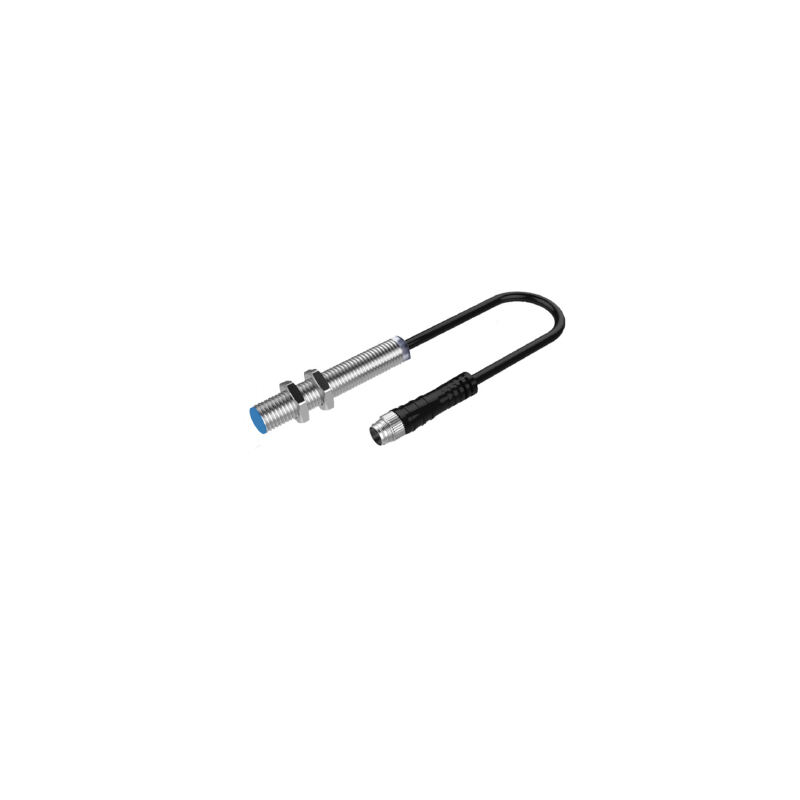Automatizazio industrial batean, hurbiltasun-sentsoreek funtsezko papera jokatzen dute kontaktu fisikorik gabeko objektuak detektatzeko. Hurbiltasun-sentsore induktiboak objektu metalikoak identifikatzeko espezializatuta daude, eta ezinbestekoak dira metal detekzioa funtsezkoa den inguruneetan. Hurbiltasun-sentsore kapasitiboek, bestalde, ankertasuna eskaintzen dute, likidoak, plastikoak eta hautsa bezalako material metalikoak eta ez-metalikoak detektatuz. Sentsore egokia aukeratzeko, bere gaitasun bereziak ulertu behar dira eta nola moldatzen diren zure behar espezifikoekin.
Indukzio-sentsoreen eta hurbiltasun-sentsore kapasitiboen ezaugarri komunak
Euskarririk gabeko detektaketa
Hurbiltasun-sentsore induktibo eta kapasitiboek objektuak detektatzen dituzte kontaktu fisikorik behar gabe. Ezaugarri honek material edo osagai sentiberen osotasuna mantentzen du detekzioan. Kontaktua gabeko detekzioak sentsoreen higadura murrizten du, eta haien bizitza luzatzen du. Gaitasun honekin objektuak detektatzeko gaitasuna lor dezakezu hainbat industria-ingurutan.
Industria-erabilpen komunak
Sentsore hauek erabilera zabala dute industrietan beren anitzak direla eta. Hurbiltasun-sentsore induktiboak metalezko objektuak detektatzeko ezin hobeak dira fabrikazio-lineetan, muntaketa-prozesuetan eta kalitate-kontrol sistemetan. Sentsore kapasitiboak, material metalikoak eta ez metalikoak detektatzeko gaitasunarekin, ezin hobeak dira likidoen mailak monitorizatzeko, osagai plastikoak detektatzeko edo poltsak detektatzeko. Euren egokitzapen gaitasunak ezinbestekoak egiten ditu automatizazio eta ekoizpen inguruneetan.
Diseinu kompaktu eta iraunkorrak
Sentsoreen diseinu kompaktuak espazio estuetan instalatzea edo makina konplexuetan integratzea ahalbidetzen du. Haien iraunkortasunak ziurtatzen du industria-baldintza latzei aurre egin diezaieketela, hautsari, hezetasunari eta bibrazioei eragin diezaietela. Sentsore bat behar baduzu tenperatura handiko ingurune baterako edo estres mekanikoak jasan ditzakeen leku baterako, sentsore hauek errendimendu fidagarria eskaintzen dute. Eraikiak dira modu sendoan, mantentze-lanak gutxiago behar direlako, denbora eta baliabideak aurreztuz.
Hurbiltasun-sentsore indukzio eta kapasitiboen arteko alde nagusiak
Funtzionamendu-printzipioak
Sentsore induktiboak eta eremu elektromagnetikoak
Hurbiltasun-sentsoreak eremu elektromagnetikoak erabiltzen dituzte. Sentsore hauek eremu magnetiko osziladorea sortzen dute bobinaren bidez. Objektu metaliko bat eremu horretan sartzen denean, osziladura eten egiten du, sentsoreak bere presentzia detektatzeko aukera ematen baitu. Printzipio honek sentsore induktiboak oso eraginkorrak egiten ditu metal ferosoak eta ez-ferroak detektatzeko. Teknologia honen laguntza behar da objektu metalikoak zehaztasun eta abiaduraz detektatzeko.
Sentsore kapazitatiboak eta edukiera aldaketak
Hurbiltasun-sentsoreak gaitasun-aldaketak detektatuz funtzionatzen dute. Sentsore hauek eremu elektrostatiko bat sortzen dute bi plaka eroaleen artean. Objektu bat, metal edo ez, eremu horretan sartzen denean, edukiera aldatzen du. Sentsoreak aldaketa hori identifikatzen du eta objektuaren presentzia adierazten du. Funtzionamendu printzipio honek sentsore kapasitiboei material anitz detektatzeko aukera ematen die, likidoak, hautsak eta plastikoak barne. Erabil ditzakezu erabilgarritasuna ezinbestekoa den aplikazioetan.
Helburu materialak
Objektu metalikoetarako sentsore induktiboak
Hurbiltasun-sentsore induktiboak bereziki objektu metalikoak detektatzeko diseinatuta daude. Metalari sentikortasuna dutelako, metalaren detekzioa ezinbestekoa den inguruneetarako dira. Adibidez, fabrikazio lerroetan erabil ditzakezu osagai metalikoak monitorizatzeko edo muntatze prozesuetan osagai metalikoen lerrokapen egokia bermatzeko. Materiala metalezkoetan jartzen dute arreta eta horrela, eszenario hauetan errendimendu fidagarria bermatzen dute.
Objektu metaliko eta ez metalikoetarako sentsore kapasitiboak
Hurbiltasun-sentsore kapasitiboek malgutasun handiagoa eskaintzen dute objektu metalikoak eta ez metalikoak detektatuz. Sentsore hauek egurra, beira, likidoak eta baita sustantzia granulatuak ere identifikatu ditzakete. Erabil ditzakezu tankeetako likido mailak kontrolatzeko, plastikozko osagaiak atzemateko, edo hautsak antzemateko prozesu industrialetan. Hainbat material maneiatzeko duten gaitasuna hainbat aplikaziorako aukera versatile bihurtzen ditu.
Sentsorearen ingurumen
Sentsore indukzioen antzematen arlo tipikoa
Hurbiltasun-sentsore induktiboek antzemateko irismen txikiagoa dute. Detekzio-distantzia objektu metalikoaren tamainaren eta motaren araberakoa da. Aplikazio gehienetan, 1 mm eta 10 mm arteko tartea da. Kontuan izan behar duzu muga hori zure proiekturako sentsore induktibo bat aukeratzen duzunean. Eremu laburragoa izan arren, sentsore hauek detekzio zehatza eta fidagarria ematen dute zehaztutako mugetan.
Sentsore kapasitiboen antzematen den eremu tipikoa
Hurbiltasun-sentsore kapasitiboek, oro har, antzemateko eremu handiagoa eskaintzen dute, sentsore induktiboekin alderatuta. Bere irismenak 25 mm-ra edo gehiago izan dezake, material eta sentsorearen diseinuaren arabera. Eremu zabaldu honek objektuak urrunago detektatzeko aukera ematen du, eta, beraz, sentsore kapasitiboak estaldura zabalagoa behar duten aplikazioetarako egokiak dira. Hainbat materialetan duten errendimendu bateratuak ingurune anitzetan detekzio fidagarria bermatzen du.
Ingurumenaren sentikortasuna
Sentsore induktiboak eta ingurumen-faktoreen aurkako erresistentzia
Hurbiltasun-sentsoreek oso ondo funtzionatzen dute ingurune zailetan. Diseinuak hauts, hezetasun eta bibrazioen aurkako erresistentzia bermatzen du. Industriako giroetan, non egoera latzetara eragin ezin den, fidagarriak dira. Sentsore hauek zehaztasuna mantentzen dute tenperatura handiko guneetan edo estres mekaniko handiko lekuetan ere. Eraikiera sendoak hondatzeko arriskua murrizten du, eta aukera fidagarria da epe luzerako erabilerarako.
Sentsore kapazitatiboak eta hezetasunaren, hautsaren eta beste faktore batzuen sentikortasuna
Hurbiltasun-sentsore kapasitiboak, nahiz eta anitzak izan, ingurumen-baldintzetan sentikorragoak dira. Hezetasuna, hautsa eta tenperaturaren aldaketak bezalako faktoreek eragina izan dezakete beren errendimenduan. Adibidez, hezetasun handia edukiera alda dezake, eta horrek detekzio faltsuak eragin ditzake. Muga horiek kontuan hartu behar dira, baldintza horietara joera duten inguruneetan sentsore kapasitiboak erabiltzean. Instalazio eta mantentze egokiak erronka horiek arintzeko eta errendimendu jarraitua bermatzeko balio du.
Kostua eta mantentzea
Indukzio-sentsoreen eta kapasitate-sentsoreen arteko kostuen alderaketa
Hurbiltasun-sentsore induktiboek kostu txikiagoa dute sentsore kapasitiboek baino. Diseinu sinpleagoa eta metal detekzioan arreta jarriz, prezio egokia lortzen dute. Sentsore kapasitibokoak, material anitz detektatzeko gaitasuna dutenez, sarritan prezio altuagoa dute. Bietako bat aukeratzerakoan, kostua zure eskaeraren eskakizun espezifikoen kontra pisatu beharko zenuke. Objektu metalikoak bakarrik detektatu behar badituzu, sentsore induktiboek irtenbide ekonomikoa eskaintzen dute.
Mantentze-kontuak mota bakoitzeko
Sentsore induktiboek mantentze gutxi behar dute iraunkortasunagatik eta ingurumen-faktoreen aurkako erresistentziagatik. Egoera zailetan instalatu ditzakezu maiz mantentze beharrik gabe. Sentsore kapasitatiboek, ordea, arreta handiagoa behar dute. Ingurumen aldaketei sentikorrak direlako, erregulartasunez begiratu eta garbitu behar dira errendimendu arazoak saihesteko. Zainketa egokiak bi sentsore mota horiek denbora luzean emaitza fidagarriak ematen dituztela ziurtatzen du, baina sentsore kapasitiboek ahalegin handiagoa eskatzen dute.
Hurbiltasun-sentsore egokia nola aukeratu
Kontuan izan helburua materiala
Hurbiltasun-sentsore egokia aukeratzeko lehen pausua detektatu beharreko materiala identifikatzea da. Zure aplikazioak objektu metalikoak dituen aplikazio bat bada, hurbiltasun-sentsore induktiboak dira aukera ideala. Diseinuak metalak zehaztasun handiz detektatzea bermatzen du, eta horrela makina monitorizatzeko edo produkzio lerroetako osagai metalikoak detektatzeko lanetarako fidagarriak dira. Materiala ez-metalikoa detektatu behar duen aplikazioetarako, likidoak, plastikoak edo hautsak, sentsore kapasitiboek behar den ankertasuna ematen dute. Materialaren propietateak ulertzeak erabaki informatu bat hartzen laguntzen dizu eta errendimendu onena bermatzen du.
Behar den sentsore-eremuaren ebaluazioa.
Sentsore egokia aukeratzeko, sentsorearen irismenaren zehaztasuna funtsezkoa da. Sentsore induktiboek irismen laburragoa eskaintzen dute, normalean 1 mm eta 10 mm artean. Horrek egoki egiten ditu objektuak sentsorearen ondoan dauden aplikazioetarako. Sentsore kapasitiboek, aldiz, sentsazio-eremu handiagoa ematen dute, askotan 25 mm edo gehiago. Zure aplikazioak urruneko objektuak detektatzea eskatzen badu, sentsore kapasitiboak dira aukera onena. Beti neurtu beharreko distantzia zure konfigurazioan, sentsoreak zure beharrak asetzen dituela ziurtatzeko.
Ingurumen-baldintzak aztertzen
Ingurumen faktoreek garrantzi handia dute sentsoreen errendimenduan. Sentsore indukzioak baldintza latzetan bikaintasuna du, hauts, hezetasun edo bibrazioak dituzten eremuetan ere bai. Diseinu sendoak eraginkortasuna bermatzen du, baita ingurune zailetan ere. Sentsore kapasitiboak, ordea, sentikorragoak dira ingurumen aldaketei dagokienez. Hezetasun handiko, hauts edo tenperaturen aldaketek eragina izan dezakete zehaztasunean. Zure aplikazioak horrelako baldintzak baditu, beharbada neurri gehiago hartu beharko dituzu, hala nola instalazio egokia edo mantentze erregularra. Ingurunea ebaluatzeak ziurtatzen du sentsoreak modu fidagarrian funtzionatzen duela eta akatsen arriskua murrizten du.
Aurrekontu eta mantentze-beharren faktorea
Hurbiltasun-sentsorea aukeratzerakoan, hasierako kostua eta epe luzerako mantentze-gastuak baloratu behar dituzu. Sentsore induktiboak sarritan prezio baxuagoan daude, objektu metalikoak detektatzera bideratutako aplikazioetarako aukera ekonomiko bihurtuz. Diseinu sendoak mantentze-lanak gutxitzen ditu, eta horrek denbora eta baliabideak aurrezten laguntzen du sentsorearen bizitza osoan.
Sentsore kapasitiboek, nahiz eta versatileagoak izan, aurre-kostu handiagoa dute. Hori material ugari detektatzeko duten gaitasunagatik da, objektu ez-metalikoak barne. Baina ingurumen-faktoreen aurrean sentikorrak direlako, beharbada garbiketa eta ikuskapen erregularretan gehiago inbertitu beharko duzu. Zure eskaerak baldintza zailak baditu, kontuan izan behar dituzu mantentze- ahalegin gehigarri horiek jabetza-gastu osoa kalkulatzerakoan.
Erabaki informatu bat hartzeko, konpara ezazu sentsorearen prezioa zure ingurune zehatzean espero den errendimendu eta iraupenarekin. Hasierako inbertsioa mantentze-beharrekin orekatzeak ziurtatzen du zure aurrekontu eta funtzionamendu-beharretara egokitzen den sentsorea aukeratzen duzula.
Kontsulta egin fabrikatzaileekin edo adituekin behar bereziak direla eta.
Aplikazio espezializatuetan, fabrikatzaileekin edo industriako adituekin kontsultatuz, ezagutza baliagarria eman daiteke. Fabrikatzaileek produktuen zehaztapenak eta zure beharretara egokitutako gomendioak eskaintzen dituzte. Zure aplikazioaren erronka bereziak eztabaidatu ditzakezu, hala nola tenperatura muturrekoak, hezetasun handia edo material zehatza detektatzea, sentsore egokiena identifikatzeko.
Adituek ere gidatu ahal izango duzu ulertzeko aurreratu ezaugarri edo personalizazioak ahal izango dute hobetu sentsorearen errendimendua. Adibidez, ingurune latzetarako babes-etxeak proposatu ditzakete edo malgutasun handiagoa lortzeko sentsibilitate-ezarpenak egokitu daitezkeen sentsoreak gomendatu. Euren esperientzia aprobetxatzeak ziurtatzen du hautatu dezakezula sentsore bat zure egungo beharrei erantzuten dien bakarra ez dena, baita etorkizuneko eskakizunei egokitzen dena ere.
Konfiantzazko profesionalekin harremanetan jartzeak akats garestiak saihesten eta zure prozesu industrialetan errendimendu onena bermatzen du. Beti lehentasuna izan konpainia bat sortzaile ospetsuekin edo aholkulari eskarmentu handikoekin emaitza onenak lortzeko.
Hurbiltasun-sentsore induktiboak metalezko objektuak detektatzeko hobekien funtzionatzen dute, zehaztasuna eta fidagarritasuna eskainiz metal-fokuatutako aplikazioetan. Sentsore kapasitiboek era askotako gaitasuna ematen dute material anitzak detektatuz, besteak beste likidoak eta plastikoak bezalako ez-metalikoak. Sentsore egokia aukeratzeko, zure aplikazioaren behar bereziak aztertu behar dituzu. Kontuan hartu behar dira helburu materiala, beharrezkoa den sentsore-eremu eta ingurune-baldintzak. Konponbide pertsonalizatuak lortzeko, kontsulta itzal handiko fabrikatzaileekin edo ikertu beste baliabide batzuk. Modu honetan, zure helburu operatiboekin bat datorren sentsorea aukeratzen duzu eta errendimendu onena ematen du.

